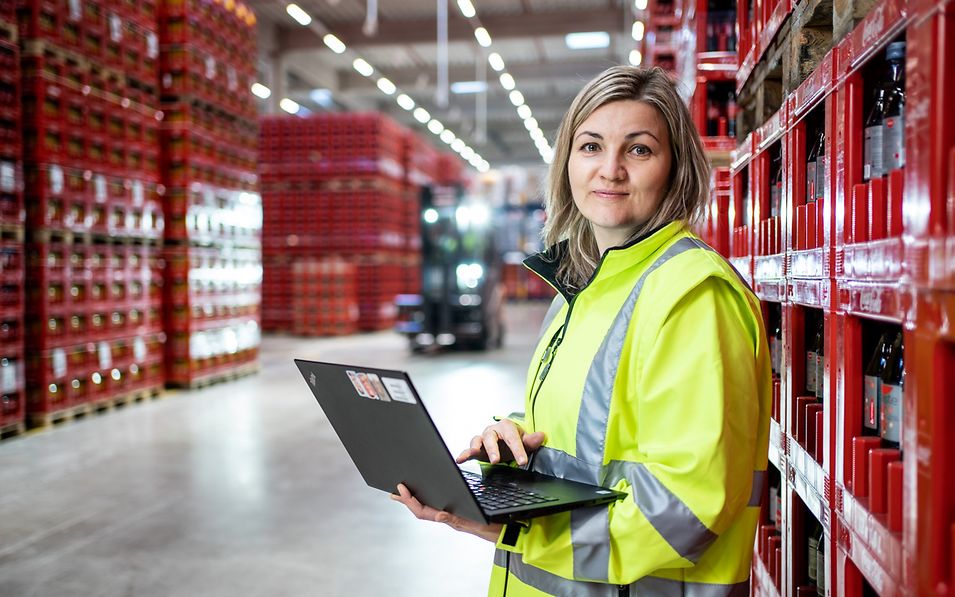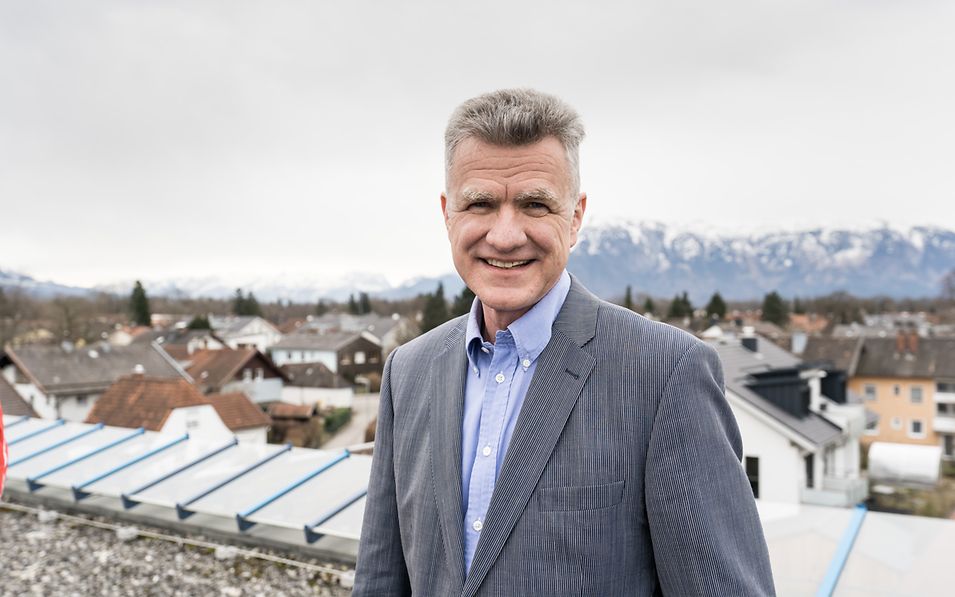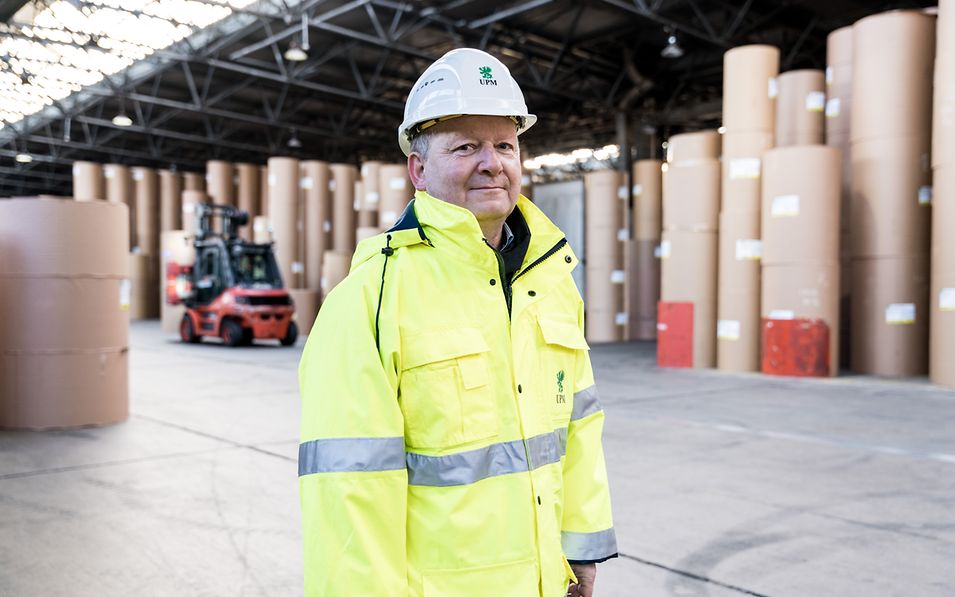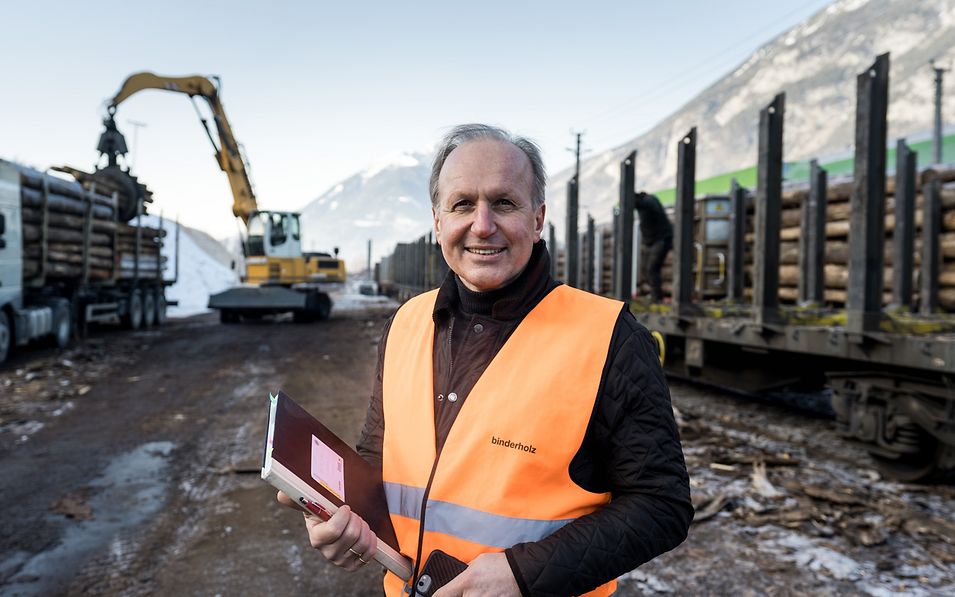People on the train
Our customers believe strongly in Strong Rail, and they’re always asking DB Cargo to come up with new, innovative solutions. We listen to them and address their concerns.
The relationships between Europe’s largest rail company and its customers often span decades, and ties have traditionally been close. Railways wanted to find out how DB Cargo’s customers perceive their logistics partner and what expectations they have for the company. We then asked employees at DB Cargo to respond. Our work resulted in five exciting pairings.
Holger Niemeier, Heinrich Niemeier GmbH & Co. KG
"When I started transporting products by rail some 16 years ago, I really had to fight hard to get DB to transport anything for us."

A lot of gravel and a little diesel
Holger NiemeierHeinrich Niemeier GmbH & Co. KG
When I started transporting products by rail some 16 years ago, I really had to fight hard to get DB to transport anything for us. Ultimately, our customer advisers helped us to clear up all of the unknowns. These days, we usually run three block trains per week as DB plantrains from our in-house gravel-washing plant at Sprotta, near Leipzig. Each of the trains carries around 2,000 tonnes of gravel to Cloppenburg. In order to handle these quantities and also to ensure we fill the capacity of the DB plantrains, we established a large transhipment site in Cloppenburg, which we can use to provide other customers with product as well. However, during the summer months, we noticed that train drivers would go on holiday, too. At those same times, a particularly large number of Saturday trains were being cancelled. We then collaborated with DB Cargo to adjust the timetable so we could do without about ten trains on Saturdays during the summer. That was a big help in improving the stability of the entire system. Last year, we were able to use the summer holiday as a kind of reserve to transport additional cargo on another route. We were able to make these transports a reality thanks to the deep dedication of our customer service representatives and the dispatchers in the German city of Duisburg. However, the run-up which we needed to make this happen demonstrates the huge scale of DB Cargo’s operations and how complex production can sometimes be. It’s a good thing that electric vehicles are used on the mainlines. However, diesel locomotives are usually used for the last mile. This interface between the electric locomotives and shunting locomotives shows how the many moving parts always need to align for trains to be able to run on schedule. Given this complexity, I’d like to see us reduce the number of interfaces, perhaps by using hybrid locomotives. That would improve flexibility and open up new opportunities, both in terms of transports and markets.
Markus TiburczyDB Cargo
I’ve only been working with Niemeier for about a year, but I’ve been working on construction materials teams for 12 years, and I’m quite familiar with the transports my predecessors handled. Mr Niemeier is my point of contact as a customer. I very much appreciate him, and can speak openly and constructively with him about any topic. That’s how we ended up quickly agreeing to use the summer break for additional transports. The system proved effective, so we’re planning to do the same thing this year. At DB Cargo, we want to transport goods in as environmentally friendly a way as possible, which makes electric locomotives our number-one choice. We still largely use diesel trains for the last mile, because there are usually no overhead lines at private sidings. Here, too, we are interested in investing in the hybrid locomotives Mr Niemeier mentioned, reducing interfaces and creating capacity for more transports. We will also achieve higher flexibility and quicker reaction times. There is a wide variety of dual-drive options on the market. Even so, we unfortunately cannot make these purchases from one day to the next. I’m certain that, by taking a new approach with hybrid locomotives hauling the cargo the entire way, we’d create opportunities to shift new transports onto the rails in our work with Mr Niemeier.
Markus Tiburczy, DB Cargo
"Mr Niemeier is my point of contact as a customer. I very much appreciate him, and can speak openly and constructively with him about any topic."

Anna Sonnenberg, Coca-Cola
"We’re currently in the process of converting our private siding in Lüneburg to be able to load the ViO train there directly."

More efficient with a private siding
Anna SonnenbergCoca-Cola
Four years ago to the day, we started working with DB Cargo at Coca-Cola’s Lüneburg site to transport drinks by rail. At the start, a route was chosen which ran from Lüneburg to a Coca-Cola site in southern Germany which is regularly supplied with ViO products. Deliveries to this site were thus shifted entirely from road to rail. DB Cargo Logistics handles all of the operational management of these transports. To carry out the transports, we coordinated with DB Cargo to develop a precise timetable, including everything from acceptance to unloading. After the timetable was successfully implemented, we added more routes for single wagonloads and combined transports. Last year, we also kicked off ViO Train, a joint project involving a block train running from Hamburg to Cologne and back every week. For this purpose, DB Cargo uses curtainside swap-bodies, which can be loaded both from the side and the rear. We’re currently in the process of converting our private siding in Lüneburg to be able to load the ViO train there directly. Not only does that save us time reloading, but it also reduces the number of intermediate transports. There are still a couple of challenges in that area, especially ensuring loads are secure. Even so, I’m certain we’ll be able to overcome them working with the team from DB.
Torsten BalasDB Cargo Logistics
Timing is always tight in the consumer goods industry. That’s why the focus is on maintaining a precise window for loading and unloading – otherwise, plans that looks great on paper simply fall apart. This is why we’re now working with Coca-Cola to eliminate a possible source of delays – transport by curtainside lorries, which still travel between the German city of Lüneburg and the container terminal in Hamburg. To this end, the capacity of the company’s private siding is being expanded in an area where sliding-wall wagons are already in use. As a result, Coca-Cola is now having to take up the topic of securing loads. That’s because there isn’t much need to secure loads hauled in sliding-wall wagons, and while truck drivers used to handle loading the curtainside containers, drivers won’t be around anymore in future. Our load advisors will therefore go directly to the customer to develop the best possible approach to loading and load securing, even running a test load. While securing loads might sound a bit complicated, ultimately we’re only talking about a few extra minutes of additional work. In the end, the approach will yield more stable transport with fewer unknowns. Coca-Cola’s example illustrates the advantages of loading at one’s own private siding, and it also shows that increasing capacity can pay off.
Torsten Balas, DB Cargo Logistics
"Coca-Cola’s example illustrates the advantages of loading at one’s own private siding."

Joachim Thonagel, UPM
"That means DB Cargo absolutely needs to do more to reliably maintain scheduled runtimes."

Arrival forecast urgently needed
Joachim ThonagelUPM
I work at UPM Communication Papers, where I am responsible for rail transport in the logistics distribution unit. We manufacture printing paper, which means we primarily send paper rolls of various dimensions to be turned into newspapers, magazines and catalogues, but we also send pallets of paper sheets and copy paper. We use DB Cargo’s single wagonload system and combined transport to transport the products by rail. Using the rails has been a key component of our transport model for decades. For example, when the customer service centre was established in Duisburg over 20 years ago, we were actively involved in the design process as a pilot customer from the very first day. For me, when it comes to rail transport, the stability of its overall performance takes precedence over other factors. Part of stability is ensuring that empty wagons arrive at our plant sites and at the port on time and that we can reliably predict the time of delivery to customers. The key concept here is the estimated time of arrival (ETA). The ETA needs to be adjusted dynamically when there are delays. This needs to happen quickly both for German and international transport, and it is very, very important to us. As a rule, we can compensate for small delays, but we need reliable information when they crop up. However, there have been incidents when the delays were so great that we had to quickly produce replacement products and deliver them by lorry. That means DB Cargo absolutely needs to do more to reliably maintain scheduled runtimes, and I truly hope that the efforts currently underway – such as building up personnel in the relevant areas and investing in digitalisation – will produce results this year.
Marit MetznerDB Cargo
I’m a logistics expert in DB Cargo’s Pulp & Paper customer service unit in Duisburg. We’re constantly working to improve the quality and reliability of pulp and paper transports on the rails. Our aspiration to present “one face to the customer” is part of that effort. It means ensuring our customers have a permanent person to contact directly. That’s why Mr Thonagel and I have a long-standing work relationship. We’ve worked together closely and have produced solid results. My colleagues and I never lose sight of the customers’ objectives and the anticipated arrival times for freight wagons, and we work hard to keep to scheduled runtimes. Mr Thonagel’s wish for reliable and early ETA forecasts has been heard, and technical solutions are being developed to address this. At the moment, we are testing ETA forecasting for block trains in Germany. The implementation for complex single wagonload traffic is part of the plan. Even now, we are working every day to leverage technology and bring our experience to bear in efforts to mitigate the impact of disruptions. An example of these efforts can be seen when construction work is scheduled. We identify alternative transport routes and promptly provide them to customers. Even when unavoidable delays occur, such as accidents, we proactively provide affected customers with updated arrival times. Going forward, I am confident that our link2rail digitalisation programme will respond even more quickly and effectively to counter incidents as they emerge. I also find it gratifying that so many of my new colleagues – increasingly train drivers, shunting locomotive drivers and wagon inspectors – are helping to improve the stability of our overall service. I’m sure Mr Thonagel will view that as a positive.
Marit Metzner, DB Cargo
"At the moment, we are testing ETA forecasting for block trains in Germany."

Sven Kruck, Tyczka
„"The digitalisation campaign is all well and good, but it cannot solve all the company’s problems."

How digital should DB Cargo be?
Sven KruckTyczka
The proportion of goods transported by rail at our company is around 50%. Most recently, we further increased the amount of freight which Tyczka transports with DB Cargo. Since liquid gas is a dangerous good, rail transport is the safest way to ship it. Rail offers particularly safe and sustainable transport. We operate our own fleet of more than 200 compressed gas tank wagons and also lease additional wagons; we primarily operate in the single wagonload system. It would therefore be a welcome step for the single wagonload product to be redesigned to make it an economical once again. The crowded parking spots for lorries on the highways are a clear sign that our road-focused system is the verge of collapse, and that shifting more traffic onto the road is not the way forward. That’s why my hope is that policymakers will continue to improve conditions for rail transport. More freight terminals and hubs would also need to be established to ensure that more goods could really be shifted to the rails. In the past, high costs have been passed along to the network users. When streets are built and maintained, all of the network costs are spread across society, leaving the whole population to bear the burden. To sum it up, we need a rail network every bit as strong and stable as our road network so we can utilise rail more heavily and use it as a durable yet flexible transportation tool. Personally, I would like for DB Cargo to keep working more on the basics. The digitalisation campaign is all well and good, but it cannot solve all the company’s problems. It’s all about commitment – offering a high-quality solution at a fair price and being straightforward about taking responsibility for the product. It’s also key that there be a constant flow of information for transport orders. If DB Cargo can improve on those points, then freight transport at Deutsche Bahn and the entire rail industry will benefit from it.
Dr Eric PfaffmannDB Cargo
We are currently carrying out the largest recruitment campaign of the last few years. We are also investing in increasing our capacity in order to shift more traffic onto the rails and boost our quality at the same time. We are enlarging our fleet by adding vehicles like multi-system locomotives and new freight wagons with special equipment to improve on the basics you mentioned. We are also aware that the single wagonload system is crucial for our customers, so we’d definitely like to upgrade and expand it. Digitalisation is a key component which we need to succeed. It helps us find cost-effective solutions. We want to make rail freight transport more comfortable and less complicated. To make these changes, we have no choice but to improve the flow of information and handle transactions in a simpler way. That’s why we are also hard at work on link2rail, which is now gradually being rolled out. link2rail is designed to be modular and scalable. The core processes in the rail business, such as ordering freight wagons, directing shipments and viewing invoices, are simple and convenient with link2rail. It’s important to have transparent information about shipments to efficiently manage logistics chains. link2rail has reached a crucial milestone by creating a consistent base of underlying data, the first of its kind in rail transport for tracking and tracing. We provide solutions to our customers in whatever way they need, be it through the online portal or by connecting directly to the customer system. The important thing is for us to travel the road to stronger freight transport together. As we see it, link2rail is a tool which simplifies access to the rails.
Dr. Eric Pfaffmann, DB Cargo
"Digitalisation is a key component which we need to succeed."

Martin Sigl, binderholz
"I also see enormous potential in intermodal transport."

Wood belongs on the rails
Martin Siglbinderholzbinderholz has had an excellent working relationship with DB Cargo Logistics for many years, and the volume of the goods we transport by rail has increased. binderholz recently carried out a green logistics plan with DB Cargo Logistics to provide daily rail service from Kösching/Ingolstadt to the ports of northern Germany. The plan allows us to take 1,600 trucks off the roads within a relatively brief span of time. Our BSH laminated timber elements, which can measure up to 34 m in length, are another example of successfully shifting freight to the rails. The close collaboration also resulted in a consistent increase in the number of wagons used to transport a growing number of our BBS/CLT solid wood building elements in international single wagonload transport. As a leading manufacturer of environmentally friendly BBS/CLT building materials, we are particularly proud of this shift in our long-distance transport and overall, we feel a great sense of responsibility to transport our products in a manner that is environmentally sustainable. We could run even more trains, but sometimes we run up against a lack of human resources, such as train drivers, shunting personnel and wagon inspectors, or we run out of wagon equipment. I also see enormous potential in intermodal transport. In my opinion, DB Cargo Logistics should expand this product further. The economy needs to change the way more goods are transported, because the collapse of our road-focused system is inevitable.
Thorsten LüttigDB Cargo Logistics
When shipping wooden construction elements for binderholz, the transport is always intermodal, because products such as BBS cross-laminated timber need to be brought to construction sites, which are almost always accessible only by roads. That’s why I understand perfectly well why this topic is so important to Mr Sigl. A few intermodal transport concepts have already been developed with Mr Sigl and our sales colleagues at DB Cargo Logistics. We’ve reviewed where and how we could move from road to rail or vice versa with no private sidings, particularly when it comes to developing product-specific load units for combined transport. We are also involving our European railports in our solutions. My team at Intermodal Logistics is responsible for supporting the development of concepts like this across various sectors. Apart from the timber industry, we also work for other multimodal-friendly industries of DB Cargo. Multi-modal transport concepts are the future. However, generally speaking, it’s always important to think about the return journey. With such slim margins, many transports will not turn a profit without a return trip. Transport solutions using combined transport load units developed for specific products don’t just need to meet the requirements of road and rail transport. Ideally, they also need to be usable for products which other customers want to transport. These are all exciting challenges, and we’re enthusiastic about helping our customers meet logistical requirements for rail transport so they can use the environmentally friendly option just as naturally as they would use other means of transport. In addition, we offer green logistics products: DBeco plus and DBeco neutral. These products represent our critical contribution to protecting the climate for the future.
Thorsten Lüttig, DB Cargo Logistics
"Multi-modal transport concepts are the future."
